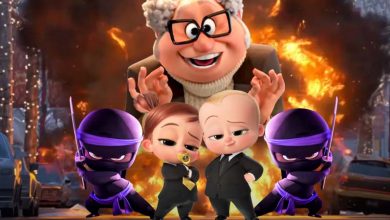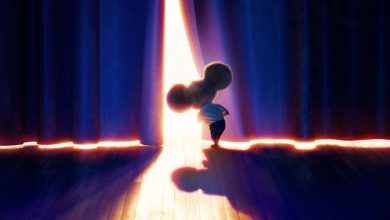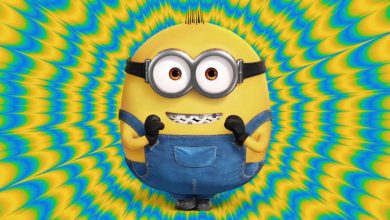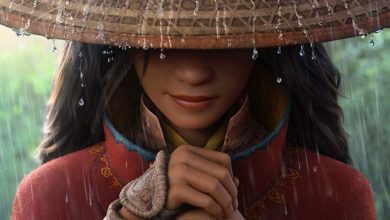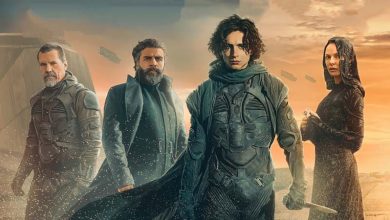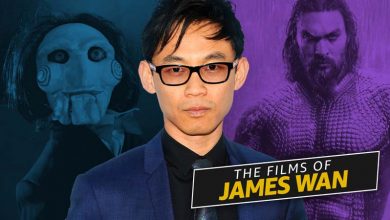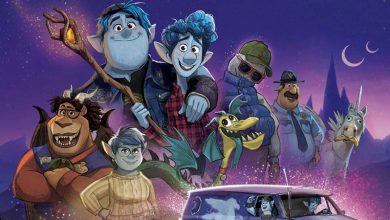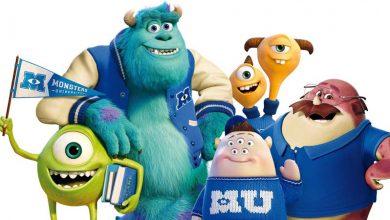Summer Wars (2009)
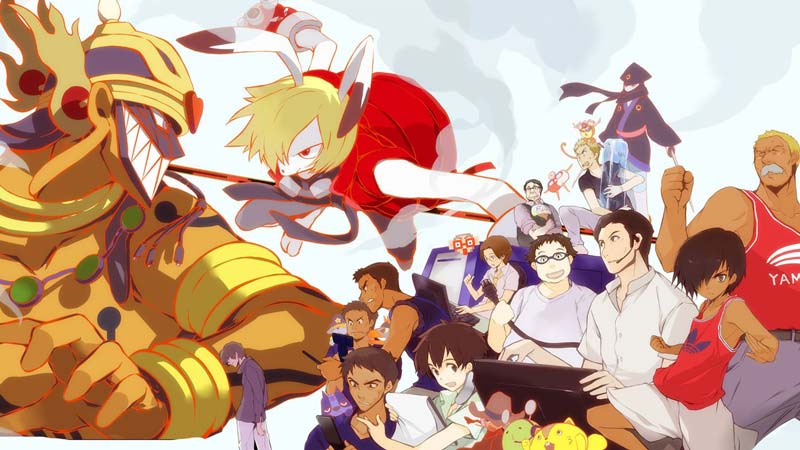
انیمه سینمایی جنگهای تابستانی (به انگلیسی Summer Wars به هیپبورن Samā Wōzu به ژاپنی サマーウォーズ) یکی از بهترین کارهای کارگردان معروف انیمه، مامورو هوسودا Mamoru Hosoda میباشد. این فیلم از محصولات استودیو مدهاوس میباشد. و در سال 2009 تولید شده است.
جنگ های تابستانی یکی از آثار عالی در مفهوم Second Life می باشد. جایی که سازنده به خوبی این مفهوم و مسائل مربوط به آن را با دنیای سایبری OZ به نمایش میگذارد. فیلم های زیادی قبل و بعد این انیمه در رابطه با این مفهوم ساخته شده اند اما قطعا Summer Wars از شاخص ترین و بهترین آنها می باشد. در این باره می توان به فیلم Ready Player One اسپیلبرگ نیز اشاره کرد.
حتما لینک های مرتبط زیر را ببینید! (آثار مامورو هوسودا)
- دانلود انیمه سینمایی دختری که در زمان پرش میکرد – 2006 The Girl Who Leapt Through Time
- دانلود انیمه سینمایی جنگ های تابستانی – Summer Wars 2009
- دانلود انیمه سینمایی فرزندان گرگ – Wolf Children 2012
- دانلود انیمه سینمایی پسر و دیو – The Boy and the Beast 2015
- دانلود انیمه سینمایی میرای – Mirai 2018
دانلود نسخه کامل فیلم
دو زبانه (انگلیسی + دوبله فارسی) – بلوری 1080p – حجم 2.27 گیگابایت دو زبانه (انگلیسی + دوبله فارسی) – بلوری 720p – حجم 1.06 گیگابایتتوضیحات مهم
به تدریج با تصحیح زیرنویس ها، گذاشتن کیفیت های بهتر و متنوع تر، افزودن PDF آموزشی، پادکست آموزشی، آموزش های ویدیویی و انواع محتواهای کمکی در کنار هر ویدیو فضای ایده آلی را برای یادگیری هرچه بهتر فراهم خواهیم کرد. وقتی ویدیوها برای شما جذاب باشه، محتوای آموزشی که کنارش ارائه میشه جذابه و توی ذهن میمونه.
حتما با شرکت در قسمت کامنت ها، به ما و دیگران و هم به خودتان برای درگیر شدن بهتر و یادگیری بیشتر کمک کنید. در واقع این مسیری که ما شروع کردیم بشدت به کاربرانش وابسته هست و خود کاربران هستند که در نهایت باعث پیشرفت خودشون و بقیه میشوند. و اینکه ما از نیروی متخصص و هرجور همکاری از طرف کاربران عزیز، برای پیشرفت این وبسایت و مسیری که پیش گرفتیم استقبال می کنیم
Info
Summer Wars (Japanese: サマーウォーズ, Hepburn: Samā Wōzu) is a 2009 Japanese animated science fiction film directed by Mamoru Hosoda, produced by Madhouse, and distributed by Warner Bros. Pictures Japan. The film’s voice cast includes Ryunosuke Kamiki, Nanami Sakuraba, Mitsuki Tanimura, Sumiko Fuji and Ayumu Saitō. The film tells the story of Kenji Koiso, a timid eleventh-grade math genius who is taken to Ueda by twelfth-grade student, Natsuki Shinohara to celebrate her great-grandmother’s 90th birthday. However, he is falsely implicated in the hacking of a virtual world by a sadistic artificial intelligence named Love Machine. Kenji must repair the damage done, and find a way to stop the rogue computer program from causing any further chaos.
After producing The Girl Who Leapt Through Time, Madhouse was asked to produce something new. Hosoda and writer Satoko Okudera, created a story about a social network and a stranger’s connection with strange family. The real-life city of Ueda was chosen as the setting for Summer Wars as part of the territory was once governed by the Sanada clan and was close to Hosoda’s birthplace in Toyama. Hosoda used the clan as the basis for the Jinnouchi family after visiting his then-fiancée’s home in Ueda.
Production of Summer Wars commenced in 2006. Art director Youji Takeshige incorporated Japanese houses into his background designs. Hosoda also insisted that 80 family members were to be included as main characters. The project was first announced at the 2008 Tokyo International Anime Fair and the first trailer of the film was released in April 2009. Audience interest was fueled primarily through word of mouth and Internet publicity.[3] A manga adaptation of the film was written by Iqura Sugimoto and began its serialization in July 2009.
Summer Wars premiered in Japan on August 1, 2009. It grossed over US$1 million in its opening weekend in 127 theaters and ranked No. 7 at the box office. The film was well received by critics and the general audience and was financially successful, earning $18 million worldwide. It won several awards such as the 2010 Japan Academy Prize for Animation of the Year,[4] the 2010 Japan Media Arts Festival’s Animation Division Grand Prize, the Anaheim International Film Festival’s Audience Award for Best Animated Feature and was nominated for the 2009 Golden Leopard award at the Locarno International Film Festival.
Plot
Kun is a boy born to an executive mother and an architect father. The family lives in a stepped house in Isogo-ku,Yokohama that Kun’s father designed around a tree, where Kun spends his days playing with the family dog, Yukko, and his beloved toy train sets. When Kun is four, his sister Mirai, Japanese for “future”, is born, and he is happy at first when his mother returns home with her. But he soon grows jealous when his parents focus all their attention on her, and has to be restrained from hitting her with one of his toy trains. He lashes out first at his mother, and then at his father when he becomes a stay-at-home dad working from home while his mother returns to work.
After one such tantrum, Kun stomps off to the house’s garden, where he meets a strange man who claims to be the “prince” of the house. As the man endlessly whines about how he lost all the parents’ attention when Kun was born, Kun realizes that the man is actually Yukko turned into a human. Kun even finds Yukko’s tail on the man; when he removes it and places it on himself, he transforms into a dog morph. Later on, a now collected Kun tells his parents about how he had so much fun running around the house as a dog, and he relays Yukko’s complaints about how they treat him.
Girls Day rolls around, and the family set up the traditional dolls to wish Mirai good luck. But they neglect to put the dolls away after the holiday ends. Frustrated again with their parents’ focus on Mirai, Kun runs back to the garden. This time he meets a middle school aged girl who claims to be Mirai from the future, whom Kun is able to recognize by the birthmark on her right hand. She has somehow gone back in time out of concern that every day the dolls are not put away adds one year before she can marry. After a lot of bumbling, future Mirai is able to put the dolls away with help from Kun and humanized Yukko.
Kun’s grandmother shows him photos of his mother when she was Kun’s age. But he continues to attack his mother by leaving his toys everywhere on the floor. He runs out to the garden again, where he is transported a couple of decades to the past. In town, he runs into a little girl whom he recognizes from the photos as his mother. The girl is angry at her mother for refusing to give her a pet cat. They return to her home, where the little girl says that things would look better all messed up, and then starts dumping toys all over the floor and food all over the table. But then her mother, Kun’s grandmother, returns home. Kun is forced out of the house and leaves out the back door, but he overhears his grandmother furiously scolding the little girl, and the girl, his future mother, sobbing hysterically. Kun returns to his own time, and now shows sympathy for his mother, but still continues to complain and whine about every little thing.
Kun gets a bike with training wheels for a present, but wants to learn how to ride the bike without them after seeing older kids on bikes at the park. His father helps him as best as he can, but Kun seems not able to keep the bike upright. Back home, Kun runs back to the garden, where he is transported to a workshop in rural Japan many decades ago. A young man with an injured leg introduces Kun to the many horses near his shop. He takes an initially afraid Kun on a ride on one of the horses, and then on his motorcycle. Back in his own time days later, Kun successfully rides his bike using what he learned from his previous rides. Kun’s mother shows him more photos, revealing the man to be his great-grandfather, who worked on motorcycles and engines in his youth but who died just recently.
Finally, the family decides to set out for a day trip. But Kun once again throws a fit over not being able to wear his favorite yellow pants (because they were in the laundry and he had to wear blue pants), and then runs off to hide. When he comes out, he finds his whole family gone. In the garden, he finds a train station (the Isogo Station) with a train approaching. A boy in his late teens warns him not to board the train, but Kun disobeys him. The train takes Kun to the Tokyo Station, but there he panics about being all alone. He finds a lost and found attendant who needs the name of a relative to page for, but Kun realizes that he doesn’t even know the names of his own parents. The attendant sends Kun to a dragon shaped bullet train, telling him that if they can’t find anyone to pick him up, he must board that train to take him to “Lonely Land,” which is essentially hell. He spots baby Mirai about to board the train and rescues her, pleading that they not be sent on this train. At this point Kun finally acknowledges that he is Mirai’s older brother, and the attendant can now page her. Baby Mirai disappears, and future Mirai shows up to take Kun home by flying through the air. They land in the tree, which houses all the family folklore. Kun sees that his father was too physically weak to ride a bike when he was young, when Yukko left his dog-mom to become a pet, that his mother stopped liking cats when she saw a stray one kill a bird, the World War II battle that left his great-grandfather’s leg injured, and the race he ran to win the heart of Kun’s great-grandmother. Kun also sees the future, and discovers that the teenager at the Isogo Station is future Kun. Back at his own time, Kun decides that he can go on the trip just fine with his blue pants, and he goes on said trip with both his parents and his little sister.

